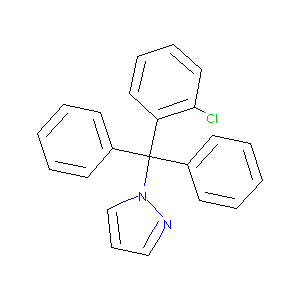Details of the Drug Combination
General Information of Drug Combination (ID: DC4USQB)
| Drug Combination Name |
Pazopanib 1-((2-chlorophenyl)diphenylmethyl)-1H-pyrazole
|
|||||||||||||||||
|---|---|---|---|---|---|---|---|---|---|---|---|---|---|---|---|---|---|---|
| Indication |
|
|||||||||||||||||
| Component Drugs | Pazopanib | 1-((2-chlorophenyl)diphenylmethyl)-1H-pyrazole | ||||||||||||||||
| N.A. | Small molecular drug | |||||||||||||||||

|

|
|||||||||||||||||
| 2D MOL | 2D MOL | |||||||||||||||||
| 3D MOL | 3D MOL | |||||||||||||||||
| High-throughput Screening Result | Testing Cell Line: KBM-7 | |||||||||||||||||
| Zero Interaction Potency (ZIP) Score: 54.53 | ||||||||||||||||||
| Bliss Independence Score: 54.53 | ||||||||||||||||||
| Loewe Additivity Score: 66.63 | ||||||||||||||||||
| LHighest Single Agent (HSA) Score: 66.63 | ||||||||||||||||||
Molecular Interaction Atlas of This Drug Combination
| Molecular Interaction Atlas (MIA) | ||||||||||||||||||||||||||||||||||||||||||||||||||||||||||||||||||||||||||||||||||||||
|---|---|---|---|---|---|---|---|---|---|---|---|---|---|---|---|---|---|---|---|---|---|---|---|---|---|---|---|---|---|---|---|---|---|---|---|---|---|---|---|---|---|---|---|---|---|---|---|---|---|---|---|---|---|---|---|---|---|---|---|---|---|---|---|---|---|---|---|---|---|---|---|---|---|---|---|---|---|---|---|---|---|---|---|---|---|---|
|
Pazopanib Interacts with 4 DME Molecule(s)
|
||||||||||||||||||||||||||||||||||||||||||||||||||||||||||||||||||||||||||||||||||||||
|
Pazopanib Interacts with 12 DOT Molecule(s)
|
||||||||||||||||||||||||||||||||||||||||||||||||||||||||||||||||||||||||||||||||||||||
| Indication(s) of 1-((2-chlorophenyl)diphenylmethyl)-1H-pyrazole |
|
|||||||||||||||||||||||||||||||||||||||||||||||||||||||||||||||||||||||||||||||||||||
|
1-((2-chlorophenyl)diphenylmethyl)-1H-pyrazole Interacts with 2 DTT Molecule(s)
|
||||||||||||||||||||||||||||||||||||||||||||||||||||||||||||||||||||||||||||||||||||||
|
1-((2-chlorophenyl)diphenylmethyl)-1H-pyrazole Interacts with 2 DOT Molecule(s)
|
||||||||||||||||||||||||||||||||||||||||||||||||||||||||||||||||||||||||||||||||||||||
References
